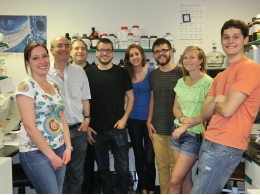The vestibular system is localized in the inner ear and provides the sense of balance. One cause of vestibular dysfunction is the loss of sensory hair cells (HCs) following exposure to ototoxic chemicals. A research team at the University of Barcelona has contributed to better understand other causes of vestibular dysfunction and recovery in chronic ototoxicity.
Jordi Llorens, researcher at the University of Barcelona and the Bellvitge Biomedical Research Institute (IDIBELL) and leader of the study, explains: “We found that symptoms of vestibular function loss appear before major damage to HCs occurs”. “To be exact —says the researcher—, we observed that hair cells and nerve terminals disconnect at early stages of the ototoxicity, and we were able to prove that this loss of connection can be repaired to some extent”.
Main ototoxicity causes are aminoglycoside antibiotics, like streptomycin, and the chemotherapeutic agent cisplatin. So far, it was known that exposure to ototoxic chemicals causes the death of the sensory hair cells, which are responsible for mechanotransduction in both the vestibular and auditory systems. This was associated with irreversible loss of function because hair cells do not regenerate. However, functional recovery was observed in some patients but with a large variability —anything from complete to null recovery—, and the causes of this recovery remained unknown.
One major class of vestibular hair cells are wrapped by nerve terminals, forming an amphora-shape structure. The study, published in the journal Disease Models and Mechanisms, identifies the initial effect of chronic ototoxicity: the elimination of junctions —named calyceal— between the cell and the neural terminal. At the molecular level, this structural change was corroborated by immunohistochemical data demonstrating major reductions in the junction protein CASPR1 and tenascin-C. Other proteins, such as the potassium channel KCNQ4, showed altered distribution due to the toxicity, disturbing the normal function of the nerve terminals.
At present, options for treating vestibular disorders are practically inexistent. However, some studies point out that they affect more than 50% of population over 60. Llorens affirms that “understanding the cellular and molecular basis of the ototoxic damage and repair may provide candidate targets for halting damage progression and promoting system’s repair”. Targets may be also useful to treat other vestibular diseases and delay age-related loss of vestibular function. Further studies will be developed thanks to a grant conferred by the Ménière’s Society. Researchers used a rat model to study the progression of vestibular dysfunction and its potential reversibility during and after exposure to nitrile. Although humans do not suffer a significant exposure to these chemicals, its effects are similar to the ones produce by aminoglycoside exposure in humans.
The vestibular system can be considered the sixth sense, but we are not enough conscious of its importance. It is located in the inner ear, behind the eardrum. In each ear, we have five vestibular sensory epithelia composed by three semicircular canals, responsible for detecting rotational head movements, and a utricle and a saccule, responsible for detecting gravity and linear motion.
Although we are not conscious, our vestibular system is constantly sensing gravity in order to adequate body posture. Moreover, it provides gaze control during movement. Vestibular damage, which lacks studies and effective treatment, may cause balance loss and, consequently, blurred vision, falls, vertigo and other disturbances.
Sedó Cabezón, L.; Jedynak, P.; BoadasVaello, P.; Llorens, J. “Transient alteration of the vestibular calyceal junction and synapse in response to chronic ototoxic insult in rats”.Disease Models & Mechanisms, October 2015. DOI:10.1242/dmm.021436

